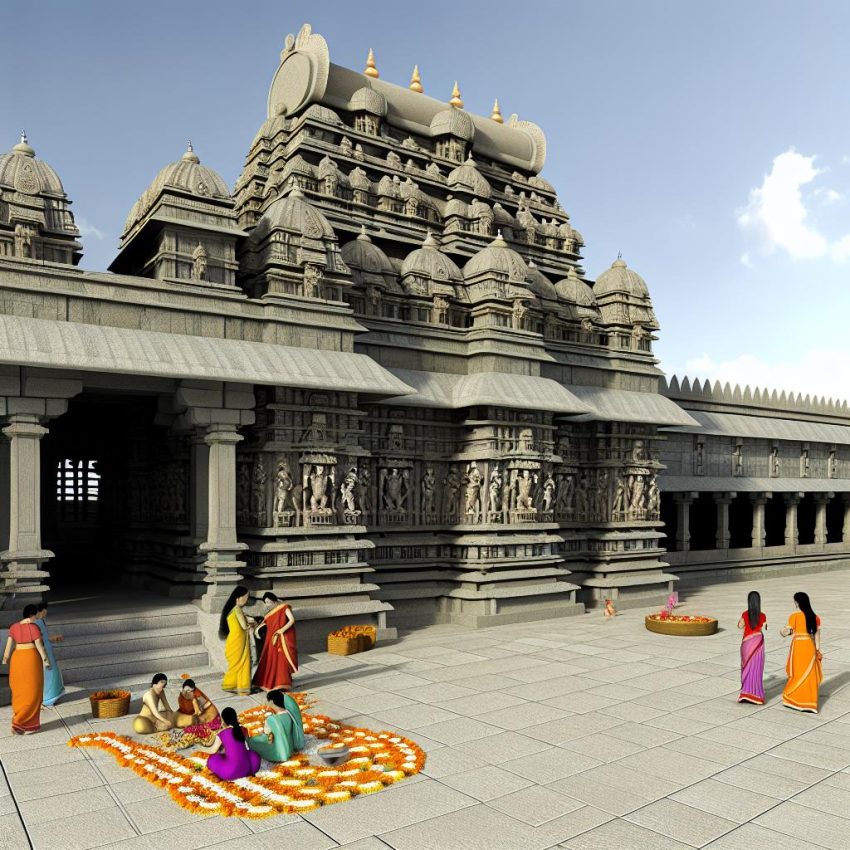Overview
The Belur Chennakeshava Temple is a remarkable historical site located in the town of Belur, within the Indian state of Karnataka. This temple is esteemed as an exemplary instance of Hoysala architecture, especially known for its ornate carvings and detailed sculptures that embellish its structure. Established in the early 12th century, the temple was commissioned by King Vishnuvardhana of the Hoysala dynasty, marking his rule with a monumental piece of architectural brilliance.
Historical Background
The origination of the Chennakeshava Temple dates back to 1117 AD. This period marked the Hoysala dynasty’s notable transition towards embracing and promoting Vaishnavism, a major tradition within Hinduism that focuses on the veneration of Lord Vishnu. The temple was constructed to celebrate King Vishnuvardhana’s triumphant victory over the Chola dynasty, a significant achievement of the Hoysala reign.
The primary deity enshrined within the temple is Chennakeshava, a manifestation of Lord Vishnu. The name Chennakeshava itself is a combination of two words from the Kannada language: Chenna, meaning “beautiful,” and Keshava, which is a descriptor for Vishnu. This nomenclature fittingly captures the essence and devotion intended for the deity by the temple’s creators.
Architectural Significance
The Belur Chennakeshava Temple stands as a testament to the grandeur of Hoysala architecture, characterized by its intricate and refined detailing. Hoysala architecture is renowned for its artistic excellence, particularly noted for the complex craftsmanship that features prominently on its surfaces. The temple’s foundation is supported by a distinct star-shaped platform, a hallmark of this architectural style.
This temple serves as an exhibition of superior artistry with its detailed carvings that colorfully illustrate narratives from revered Hindu epics such as the Ramayana and the Mahabharata. These narrative carvings not only showcase the aesthetic sensibility of the time but also reflect the rich cultural values and religious beliefs embedded in the region’s heritage.
Sculpture and Ornamentation
The sculpture work of the Belur Temple is undeniably striking and stands out as one of its most celebrated aspects. The adornments found on the temple’s walls, pillars, and ceilings consist of thousands of intricate motifs. These adornments include depictions of deities, musicians, dancers, and various animals, each carefully and meticulously carved to leave a lasting impression.
Among the most notable sculptural works are the renowned bracket figures, known as Madanikas or Shilabalikas. These figures are particularly significant due to their unique expressive poses and intricacies. Each Madanika captures the viewer’s intrigue, providing a glimpse into the artistic zenith achieved during the Hoysala period. These sculptures are instrumental not only in adorning the temple but also in narrating the cultural tales and folklore through their forms.
The Temple Complex
The Belur Chennakeshava Temple complex is not limited to the main sanctum alone but encompasses several supplementary structures and shrines, each contributing to the temple’s grandeur and spiritual ambiance. Notable among these is the Kappe Chennigaraya temple, which was commissioned by Vishnuvardhana’s queen, Shantala Devi. This highlights the involvement and contributions of royal women in art and religious practices during the Hoysala era.
Within the complex, the main hall, known as the mandapa, is an open-air structure that provides a spectacular view of the temple’s famous round pillars. These pillars are artistically crafted and bear testament to the advanced engineering and artistic skills possessed by artisans of the period. The central dancing hall of the mandapa was historically utilized for traditional dances, reflecting the cultural and artistic vibrancy of the Hoysala dynasty.
For those interested in exploring beyond just the historical and architectural aspects, the temple complex offers a deep cultural experience, encompassing the beliefs, traditions, and artistry of a bygone era.
Learn more about tourism in Karnataka.
In conclusion, the Belur Chennakeshava Temple remains an architectural marvel, encapsulating the cultural and artistic prowess of the Hoysala dynasty. Visitors who explore this historic monument are often left enthralled by its artistically detailed carvings and the timeless narratives captured in stone. This makes the temple an essential visit for anyone with an interest in historical heritage and architectural wonder.
